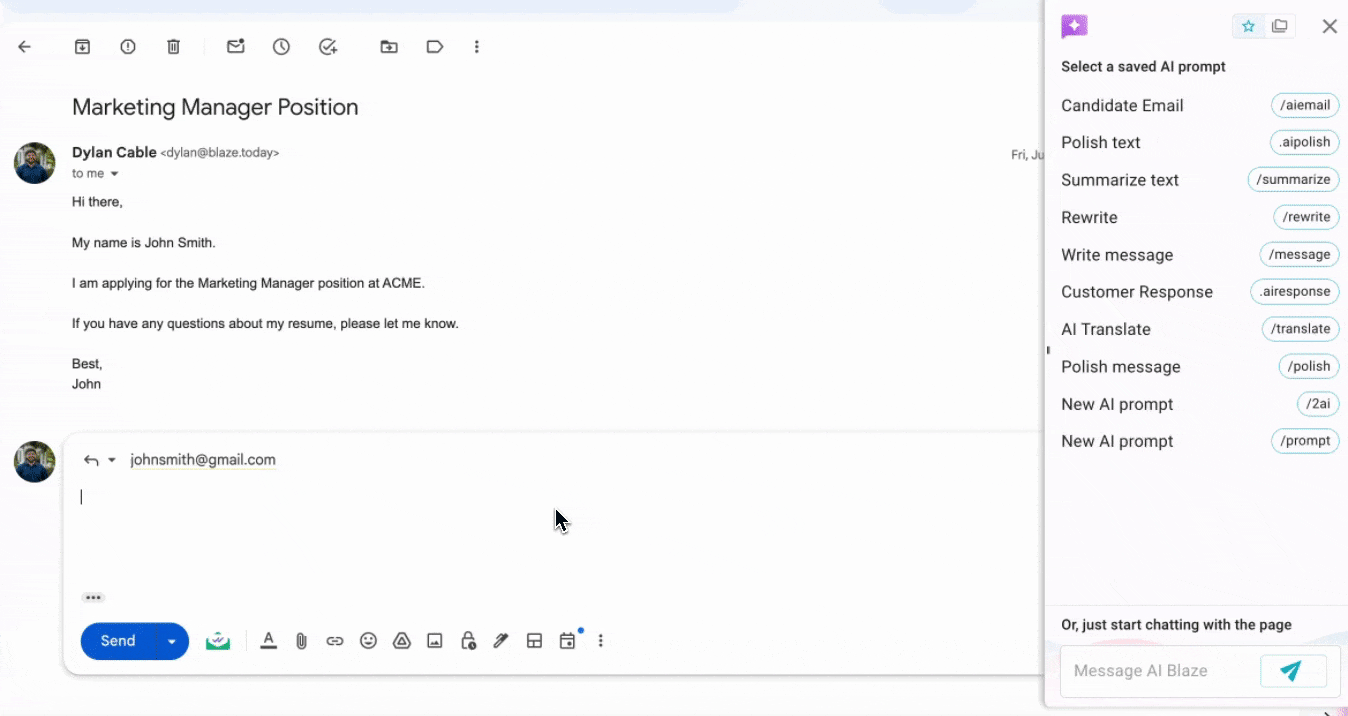How to Write Effective AI Prompts in 2026 + Prompt Generator Template
Use these tips to write effective AI prompts in ChatGPT, Midjourney, stable diffusion, and more.
Knowing how to talk to AI effectively has become a must-have skill with the explosion of AI tools in 2026.
Research shows that about 1 in 3 firms are experimenting with limited implementation of AI.
Whether you're just getting started with AI or you've been using it for a while, being able to give clear instructions can make a huge difference.
This guide is all about teaching you to craft prompts that get you exactly what you need from AI, whether that's a piece of writing, an image, or an answer to a question.
In this article, we'll cover what you should include in AI prompts (on any platform) and provide 20 templates you can use to get started today.
What Are AI Prompts?
AI prompts are like starting points or questions that you give to an AI system to get it to do something or answer you in a certain way. Think of them as the initial push in a conversation with AI, guiding it on what you're looking for.
The quality and clarity of these prompts are super important because they shape the AI's response. A well-thought-out prompt can lead to precise, useful answers or creations, while a vague or confusing prompt might not get you what you need.
In short, the better your prompt, the better your results from the AI.
Why Are Effective AI Prompts Important?
Writing effective AI prompts is crucial for a couple of key reasons. First, it ensures that you get accurate and relevant responses from the AI, saving you time and possibly frustration.
If the AI clearly understands what you're asking, it can provide you with exactly what you need, whether that's an answer, a piece of content, or a creative work.
Also, effective prompts help in making the most out of the AI's capabilities. By clearly communicating your needs, you're more likely to explore the full range of what the AI can do for you, leading to more innovative and useful outcomes.
Use AI Blaze to automate your work anywhere with AI.
How to Write Effective AI Prompts
An effective AI prompt is clear and direct, guiding the AI to understand exactly what you're looking for. It combines specificity with enough detail to ensure the AI can generate a precise and useful response or output.
When writing an AI prompt, it's important to ask yourself a few key questions:
- What exactly do I need from the AI?
- How can I phrase my request to be both specific and clear?
- Is there any context or detail that could help the AI understand my request better?
- What is the desired outcome or format of the AI's response?
ChatGPT Prompts
For ChatGPT prompts, clarity is your best friend. Be as specific as possible about what you're asking for, whether it's a piece of advice, a detailed explanation, or a creative story.
Including context helps ChatGPT understand the background of your request, leading to more tailored and relevant responses.
Avoid ambiguity to prevent responses that might not align with your expectations.
- Key Tip: Ensure your prompt is detailed enough to guide ChatGPT, yet flexible enough to allow for comprehensive and nuanced answers.
Midjourney Prompts
Midjourney prompts benefit greatly from a blend of specificity and open-endedness to spark creativity.
This tool is designed to explore ideas or concepts, so guiding it with a clear direction while leaving room for imaginative outcomes works best.
Consider framing your prompt in a way that encourages exploration within a defined boundary to get the most out of Midjourney's capabilities.
- Key Tip: Balance clarity with creativity to inspire Midjourney to generate unique and thought-provoking outputs.
Stable Diffusion Prompts
When writing prompts for Stable Diffusion, focus on creating vivid, descriptive requests. Since Stable Diffusion generates images, your prompts should paint a clear picture of what you envision.
Include details about elements, style, and mood to guide the AI in creating visuals that match your expectations.
The more descriptive you are, the closer the outcome will be to what you're imagining.
- Key Tip: Precision in visual descriptions is crucial for guiding Stable Diffusion to produce images that meet your expectations.
Dall-E Prompts
Dall-E prompts should be highly visual and detailed, as Dall-E excels in turning text descriptions into images. Think about the composition, themes, and any specific elements you want included in your image.
Describing the scene, emotions, or atmosphere you're aiming for can help Dall-E generate artwork that closely aligns with your vision. Creativity paired with precision in your descriptions will yield the best results.
- Key Tip: Crafting a prompt with vivid imagery and clear details enhances Dall-E's ability to create accurate visual representations.
Google Bard Prompts
Google Bard prompts should be structured to leverage the AI's ability to generate informative and insightful text.
Clearly outline the topic you're interested in exploring and any specific questions or angles you want covered.
Providing context or specifying the type of information you're seeking (such as summaries, analyses, or creative interpretations) can help Google Bard tailor its response more effectively to your needs.
- Key Tip: Directly stating the purpose of your query or the format you prefer can significantly improve the relevance and quality of Bard's responses.
What to Avoid When Writing AI Prompts
When you're crafting AI prompts, there are certain things you definitely want to steer clear of to ensure the AI understands you and gives back the best possible response.
Here's what not to do when writing AI prompts:
Avoid ambiguity: Vague prompts can lead to responses that are off-topic or not what you were hoping for.
Don't use complex language: Keep it simple, as complicated jargon can confuse the AI or lead it astray.
Try not to ask multiple questions in one prompt: This can dilute the AI's focus, resulting in answers that don't fully address any of your questions.
Don't over-complicate your prompt: Asking AI to do too much at once isn't a great idea. It's better to ask it to do one thing at a time.
Avoid providing insufficient context/detail: If the AI lacks the necessary background information, it may not be able to generate a relevant response.
Forget the AI's capabilities: Remember, AI tools like ChatGPT and Google Bard (Gemini) are trained, but they can't answer every question you have with 100% accuracy.
Keeping these points in mind can help you craft better prompts that lead to more accurate and useful interactions with AI.
How to Use GPT-4 Anywhere

If you are tired of copy/pasting AI prompts, give AI Blaze a try.
AI Blaze is a Chrome extension that allows you to instantly use GPT-4 on any site.
Whether you need to write/improve text, summarize pages, or translate languages, AI Blaze helps you do it in seconds with AI!
Features
Use GPT-4 instantly anywhere you work with keyboard shortcuts and a dynamic AI assistant sidebar.
Create dynamic AI prompts with placeholders, drop-down menus, toggle fields, if/else rules, and more.
Boost your communication with AI by writing or improving your messages anywhere in seconds.
Share AI prompts with your team to boost your team's productivity, communication, and workflows.
Use AI Blaze to automate your work anywhere with AI.
Write Effective AI Prompts With Ease!
Writing effective AI prompts is both an art and a science, requiring a blend of clarity, specificity, and creativity.
By following the guidelines and utilizing the templates provided in this blog post, you'll be well on your way to enhancing your interactions with AI across various platforms.
Use AI Blaze to instantly use GPT-4 on any site to boost your communication and automate work anywhere.




